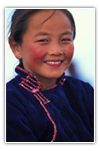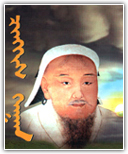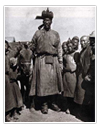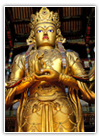- Population
- Mongolia has a population of approximately 2.7 million (the rest are minority peoples in China and the Soviet Union), population density is only 3.6 persons per square mile. The population is split between urban and rural dwellers. Except for a concentration of 1,000,000 people in Ulaanbaatar, the capital, the rest of the population is sparsely distributed in rural urban areas in the vast countryside.
 The most of the population is young and growing rapidly. About 82 percent of the population, however, is of the Khalkh ethnic group, making the nation extremely homogeneous; in the western part of the country, the largest ethnic groups are the Kazakh (5 percent), the Uriankhai-Tuva, the Tsaatan and the Khoton. Descendants of the Oirad speak a slightly different dialect of Mongolian. They are subdivided into several ethnic groups: the Bayad (2.1 percent), the Durvud (2.8 percent), the Zakhchin, Myangat, Uuld and the Torguud. The Buryad represent 1.7 percent of the population. Among the other groups are the Dariganga (1.3 percent) in the south-east of the country, as well as the Uzemchin and Barga in the west. « less
The most of the population is young and growing rapidly. About 82 percent of the population, however, is of the Khalkh ethnic group, making the nation extremely homogeneous; in the western part of the country, the largest ethnic groups are the Kazakh (5 percent), the Uriankhai-Tuva, the Tsaatan and the Khoton. Descendants of the Oirad speak a slightly different dialect of Mongolian. They are subdivided into several ethnic groups: the Bayad (2.1 percent), the Durvud (2.8 percent), the Zakhchin, Myangat, Uuld and the Torguud. The Buryad represent 1.7 percent of the population. Among the other groups are the Dariganga (1.3 percent) in the south-east of the country, as well as the Uzemchin and Barga in the west. « less
- Mongolia in the 13th century
- Mongolia is famous for its heritage of ancient history in the world. The historic heritage of Mongolia is mainly related to Chinggis Khaan, the warrior-statesman, who in the 13th century, united the Mongolian people into a strong nation and conquered a swath of the world from modern-day Korea to southern Russia and in invading deep into Europe, and the cultural achievements of his grandson, Khubilai Khan, in China are well-known in world history.
- more »
- Mongolia in 20th century
- After the collapse of the empire, Mongolia was subjugated by Manchu dynasty for 200 hundred years, and then in 1911 the Mongols Monarchy was established.
- more »
- Modern Mongolia
- In 1990’s, Mongolia transferred to Free Market economy and Democracy, and set the goal of building “democratic human socialism” based on a multi-party democracy. The great civilization started with the support of Soviet Union. In January 1992, a new constitution was established.
- more »
- Geography
- Mongolia, the ancient nomadic Mongols is located in the heart of Central Asia. It borders with the Russia in the north and the People's Republic of China in the south. Mongolia's total land area is 604,250 square miles (1,564,116 km²).
- more »
- Climate
- This is a country with hot in the summer and extremely cold in the winter, with January averages dropping as low as -30°C (-22°F). The country is also subject to occasional harsh climatic conditions known as zud. Ulan Bator has the lowest average temperature of any national capital in the world.
- more »
- People
- Based on Mongolia's history, particularly the tales of Chinggis Khan, visitors sometimes expect modern Mongolians to be rough, warlike, or even hostile towards strangers.
- more »
- National holidays
 • New Year's Day - 1st January,
• New Year's Day - 1st January,
• Tsagaan Sar - According to Lunar Calendar,
• Mother & Children's Day - 1st June,
• National Naadam Festival - 11-13th of July
• Independence Day - 26th November.- more »
- Religion
- Various forms of Tengriism and Shamanism have been widely practiced throughout the history of what is now modern day Mongolia; as such beliefs were common among nomadic people in Asian history. Such beliefs mostly gradually gave way to Tibetan Buddhism, but Shamanism has left a mark on Mongolian religious culture.
- more »
- Nomads
- Present-day Mongolia is famous for its heritage of ancient history, culture and arts, specific traditions and custom, indigenous species of the world's rare animals. Two distinctive features of the Mongolian culture are nomadic way of life and Tibetan Buddhism that widespread as the major religion in Mongolia.
- more »
- Ulaanbaatar
 Ulaanbaatar, which means Red Hero, is the capital and the largest city of Mongolia. It is the country’s main center of politics, business and finance, culture and science. About half of the country's populations live in the capital city.
Ulaanbaatar was founded in 1639 as Urguu a mobile monastery-town, it was often moved to various places along the Selenge, Orkhon and Tuul rivers. In 1778, the city settled for good at its current location, near the confluence of the Selbe and Tuul rivers and beneath Bogd Khan Uul, back then also on the caravan route from Beijing to Kyakhta. The city consists of a central district built in Soviet 1940s and 1950s-style architecture, surrounded by and mingled with residential concrete tower blocks and large yurt quarters. In recent years, a lot of the towerblock's ground floors have been modified and upgraded to small shops, and many new buildings have been erected.
Ulaanbaatar, which means Red Hero, is the capital and the largest city of Mongolia. It is the country’s main center of politics, business and finance, culture and science. About half of the country's populations live in the capital city.
Ulaanbaatar was founded in 1639 as Urguu a mobile monastery-town, it was often moved to various places along the Selenge, Orkhon and Tuul rivers. In 1778, the city settled for good at its current location, near the confluence of the Selbe and Tuul rivers and beneath Bogd Khan Uul, back then also on the caravan route from Beijing to Kyakhta. The city consists of a central district built in Soviet 1940s and 1950s-style architecture, surrounded by and mingled with residential concrete tower blocks and large yurt quarters. In recent years, a lot of the towerblock's ground floors have been modified and upgraded to small shops, and many new buildings have been erected.
- more »
All rights reserved.
www.gucci.gy / www.gucci.re / www.gucci.gd / www.gucci.mu / www.gucci.ru
www.gucci.sx / www.gucci.cx / www.gucci.io / www.gucci.tl / www.gucci.mn
www.gucci.lc / www.gucci.gg / www.gucci.gl
www.gucci.com.cm / www.gucci.com.gl / www.gucci.com.ms / www.gucci.com.so
www.gucci.com.pe / www.gucci.com.im / www.gucci.com.ro / www.gucci.com.vc
www.gucci.gy / www.gucci.re / www.gucci.gd / www.gucci.mu / www.gucci.ru
www.gucci.sx / www.gucci.cx / www.gucci.io / www.gucci.tl / www.gucci.mn
www.gucci.lc / www.gucci.gg / www.gucci.gl
www.gucci.com.cm / www.gucci.com.gl / www.gucci.com.ms / www.gucci.com.so
www.gucci.com.pe / www.gucci.com.im / www.gucci.com.ro / www.gucci.com.vc









 In 1206, Temuujin became Chinggis Khaan, the great khaan of the Mongols, having succeeded in rallying to his person all the dispersed Mongol and Turkish tribes, and having destroyed his powerful enemies, the Tatars, the Khereid, and the Naiman, and their entire race was scattered like ashes. Three phases were notable in the years after the 1206 coronation.
In 1206, Temuujin became Chinggis Khaan, the great khaan of the Mongols, having succeeded in rallying to his person all the dispersed Mongol and Turkish tribes, and having destroyed his powerful enemies, the Tatars, the Khereid, and the Naiman, and their entire race was scattered like ashes. Three phases were notable in the years after the 1206 coronation. The struggle of D.Sukhbaatar and his fellow revolutionaries against the Manchu brought about complete political and territorial independence in 1921.
As the result of the Mongolian People’s revolution in 1921, Mongolia was released from Manchu colonization. It was dark years under the oppression of Manchu that had made Mongolia left behind world development.
The struggle of D.Sukhbaatar and his fellow revolutionaries against the Manchu brought about complete political and territorial independence in 1921.
As the result of the Mongolian People’s revolution in 1921, Mongolia was released from Manchu colonization. It was dark years under the oppression of Manchu that had made Mongolia left behind world development.
 The first President of Mongolia was elected by public election in 1993, which was very new to the people that they actually had the opportunity to choose their own leader. The president is elected for a four year term. The Mongolian first president was P.Ochirbat. Mongolia elects the Parliament on national level. The State Great Assembly, the parliament has 76 members, elected for a four year term in single-seat constituencies. Heavy industries, power plants, secondary schools, railways, telephone stations and telegraph lines have been built. A number of people increased who settled in major big cities such as Ulaanbaatar, Darkhan, Erdenet and Dornod.
The first President of Mongolia was elected by public election in 1993, which was very new to the people that they actually had the opportunity to choose their own leader. The president is elected for a four year term. The Mongolian first president was P.Ochirbat. Mongolia elects the Parliament on national level. The State Great Assembly, the parliament has 76 members, elected for a four year term in single-seat constituencies. Heavy industries, power plants, secondary schools, railways, telephone stations and telegraph lines have been built. A number of people increased who settled in major big cities such as Ulaanbaatar, Darkhan, Erdenet and Dornod.  Mongolia is the fifth largest country in Asia and the seventeenth largest in the world. It is more than two times larger than the U.S. state of Texas and slightly larger than Spain, France and Germany combined.This beautiful country of forever-blue sky is surrounded by High Altai Rocky Mountains in the west; dense forested areas in the north, vast plain in the east, and Gobi desert in the south. Much of Mongolia consists of steppes. The highest point in Mongolia is the Khuiten Peak in the Tavan Bogd massif in the far west at 4,374 m (14,350 ft). The basin of the lake Uvs Nuur, shared with Tuva Republic in Russia, is a natural World Heritage Site.
Mongolia is the fifth largest country in Asia and the seventeenth largest in the world. It is more than two times larger than the U.S. state of Texas and slightly larger than Spain, France and Germany combined.This beautiful country of forever-blue sky is surrounded by High Altai Rocky Mountains in the west; dense forested areas in the north, vast plain in the east, and Gobi desert in the south. Much of Mongolia consists of steppes. The highest point in Mongolia is the Khuiten Peak in the Tavan Bogd massif in the far west at 4,374 m (14,350 ft). The basin of the lake Uvs Nuur, shared with Tuva Republic in Russia, is a natural World Heritage Site.  Mongolia is high, cold, and windy. It has an extreme continental climate with long, cold winters and short summers, during which most of its annual precipitation falls. The country averages 257 cloudless days a year, and it is usually at the center of a region of high atmospheric pressure. Precipitation is highest in the north (average of 20 to 35 centimeters per year) and lowest in the south, which receives 10 to 20 centimeters annually. The extreme south is the Gobi, some regions of which receive no precipitation at all in most years. The name "Gobi" is a Mongol term for a desert steppe.
Mongolia is high, cold, and windy. It has an extreme continental climate with long, cold winters and short summers, during which most of its annual precipitation falls. The country averages 257 cloudless days a year, and it is usually at the center of a region of high atmospheric pressure. Precipitation is highest in the north (average of 20 to 35 centimeters per year) and lowest in the south, which receives 10 to 20 centimeters annually. The extreme south is the Gobi, some regions of which receive no precipitation at all in most years. The name "Gobi" is a Mongol term for a desert steppe.  Nothing could be further from the truth.
The precarious and challenging nature of nomadic life has in fact shaped the need for the unique hospitality and genuine warmth extended to all travelers and pilgrims in Mongolia.
Nothing could be further from the truth.
The precarious and challenging nature of nomadic life has in fact shaped the need for the unique hospitality and genuine warmth extended to all travelers and pilgrims in Mongolia. Mongolians are very religious people and stay faithful to their belief during their whole life. Even though, last few years other religious groups like Christians flow introduced to Mongolia strongly most of the people still belief in Buddhism. Tibetan Buddhism is the main religion it represents 80% of Mongolian population; however, elements of 4% Muslims, 6% of Christians and Shamanism are also practiced. As of 2004, there were 186 religious centers operating in Mongolia. Of this total, 112 are Buddhist monasteries and 65 are Christian. These numbers, however, are disproportionate to the actual practitioners of Christianity and Buddhism. Despite this, Buddhism has undergone a revival since 1990, resulting in the construction of dozens of new monasteries, and the restoration of temples destroyed in the 1930s. The Buddhist art school at Gandan Monastery is thriving and high lamas from Tibet, Nepal and India have trips to Mongolia.
Mongolians are very religious people and stay faithful to their belief during their whole life. Even though, last few years other religious groups like Christians flow introduced to Mongolia strongly most of the people still belief in Buddhism. Tibetan Buddhism is the main religion it represents 80% of Mongolian population; however, elements of 4% Muslims, 6% of Christians and Shamanism are also practiced. As of 2004, there were 186 religious centers operating in Mongolia. Of this total, 112 are Buddhist monasteries and 65 are Christian. These numbers, however, are disproportionate to the actual practitioners of Christianity and Buddhism. Despite this, Buddhism has undergone a revival since 1990, resulting in the construction of dozens of new monasteries, and the restoration of temples destroyed in the 1930s. The Buddhist art school at Gandan Monastery is thriving and high lamas from Tibet, Nepal and India have trips to Mongolia.  The city offers a broad range of tourist attractions such as museums and monasteries as well as urban services. Among the notable older monasteries older monasteries is the Choijin Lama Monastery, a Buddhist monastery that was completed in 1908. It escaped the destruction of Mongolian monasteries when it was turned into a museum in 1942. Gandan Monastery, which dates to the 19th century. Its most famous attraction is a 26.5 meter high golden statute of Migjid Janraisig. These monasteries are among the very few in Mongolia to escape the wholesale destruction.
The city offers a broad range of tourist attractions such as museums and monasteries as well as urban services. Among the notable older monasteries older monasteries is the Choijin Lama Monastery, a Buddhist monastery that was completed in 1908. It escaped the destruction of Mongolian monasteries when it was turned into a museum in 1942. Gandan Monastery, which dates to the 19th century. Its most famous attraction is a 26.5 meter high golden statute of Migjid Janraisig. These monasteries are among the very few in Mongolia to escape the wholesale destruction.  It is the main hub from which foreign tourists start their adventure in this beautiful land. Ulaanbaatar has something for everyone to enjoy with a wide range of performing arts and entertainment, from the traditional throat singing and spectacular contortionist to the likes of concerts pianists, ballerinas, and opera singers. Energetic and always exciting, Ulaanbaatar’s club scene demands to be experienced. Many clubs are as cosmopolitan as they come; sporting trendy venues, sound systems and drinks menus. Expect everything from locally brewed Chinggis beer and top-brand lagers to world class wines and creative cocktails. Shopping in Ulaanbaatar is an experience to thrill and delight the shoppers. From the gleaming department stores to the famous hustle and bustle “black market”, Ulaanbaatar has all kinds of places to spend your money such as stylish cashmere outlets.
It is the main hub from which foreign tourists start their adventure in this beautiful land. Ulaanbaatar has something for everyone to enjoy with a wide range of performing arts and entertainment, from the traditional throat singing and spectacular contortionist to the likes of concerts pianists, ballerinas, and opera singers. Energetic and always exciting, Ulaanbaatar’s club scene demands to be experienced. Many clubs are as cosmopolitan as they come; sporting trendy venues, sound systems and drinks menus. Expect everything from locally brewed Chinggis beer and top-brand lagers to world class wines and creative cocktails. Shopping in Ulaanbaatar is an experience to thrill and delight the shoppers. From the gleaming department stores to the famous hustle and bustle “black market”, Ulaanbaatar has all kinds of places to spend your money such as stylish cashmere outlets. 